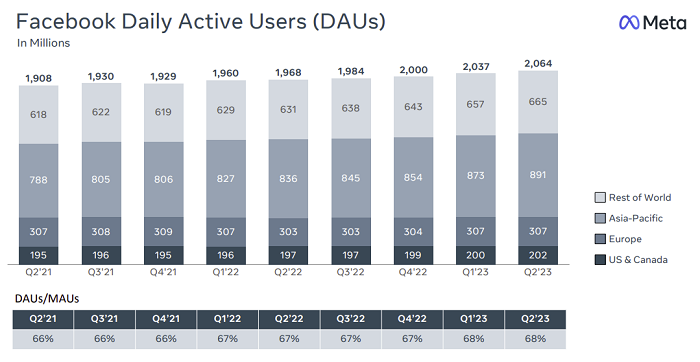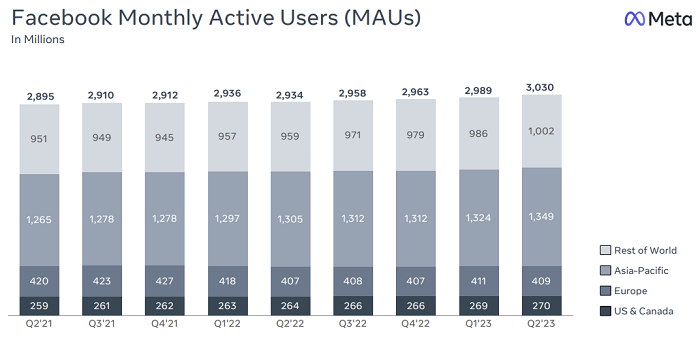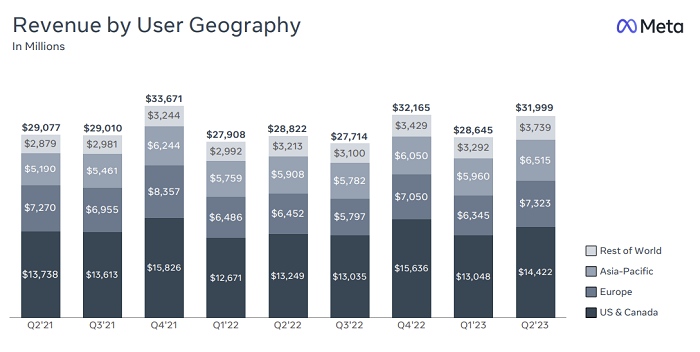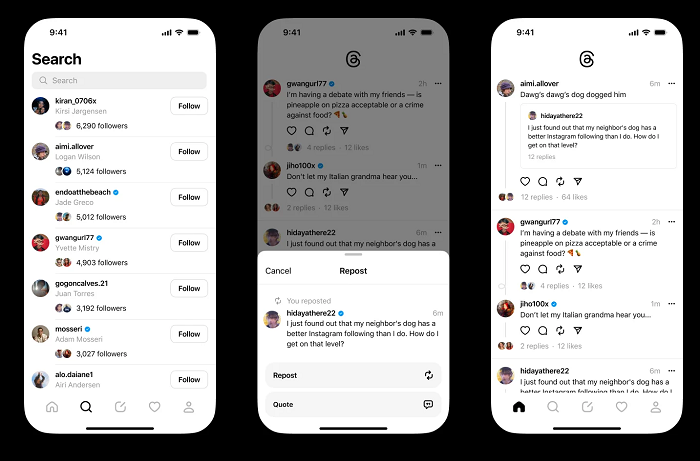Meta has shared its latest performance update, which shows that Facebook added another 27 million users in the most recent quarter, while it also crossed 3 billion monthly actives for the first time, showing that there’s still life in the big blue app yet.

As you can see in this graph, the majority of Facebook’s user growth is still coming from the Asia Pacific region, where the app is seeing steady take-up in developing markets, including India and Indonesia. Improvements in local connectivity are bringing more people online, which logically sees more of them logging into the app, though growth in EU and U.S. has largely stalled, reflecting mass adoption in these regions.

That’s largely the same in the monthly user counts, though as you can see, European Facebook usage has actually declined once again, after seeing a slight jump last quarter.
Really, Facebook’s not the cool app of the moment, so it makes sense that some attention is waning in established markets. But even so, 3 billion monthly actives is a huge milestone, which no other app is even close to at this stage.
In terms of revenue, Meta brought in $32 billion for the period, an 11% increase year-over-year.

The challenge for Meta, as it is for all social companies, is that while its seeing growth in developing regions, it’s still hugely reliant on its established markets for revenue, and it’ll take time before these new users bring in significant profit.
But still, $32 billion is a strong result, amid shifting economic conditions, which reinforces Meta’s ongoing strength and durability, in alignment with the latest ad market swings.
In terms of ad performance, Meta says that ad impressions delivered across its apps increased by 34% year-over-year in Q2, while the average price per ad decreased by 16%. Meta’s still finding more ad opportunities, and developing new placement options, and while more ads could impact the user experience, clearly, the overall usage numbers have remained steady, despite this rise.
And this is before you consider the potential of Threads as an ad platform, which is not on the cards as yet, but may be soon.
In terms of costs, Reality Labs, its VR/AR division, continues to weigh down its results, posting a $3.7 billion loss for the quarter, which is pretty much in line with the performance that it’s seen over the last year.
Meta’s VR headset sales fell again in the period, though that could change later this year, with the release of its Quest 3 units, which offer advanced connectivity and control for its next-level experiences.
VR remains an uncertain element, but an essential part of Meta’s metaverse vision, so you can expect that investment to continue rising, as Meta seeks more ways to bridge people across into its wholly digital plane, which may one day be how we all engage and interact.
Meta’s currently on track to lose $15 billion in VR investment for the full year, which would best last year’s $14 billion loss in VR development.
But really, the key highlight of the period for Meta has been the launch of its Twitter competitor Threads, which reached 100 million users in record time, and has helped to reignite interest in Meta’s social offerings, as Twitter cast-offs look for a new outlet.

TikTok had largely stolen Meta’s thunder in this respect, supplanting both Facebook and Instagram as the key app of choice, and realigning social media behaviors around entertainment, as opposed to friend connection. That forced Meta into catch-up mode, and it’s since been applying similar algorithmic approaches to its apps, seeking to highlight the best content from across each platform, as opposed to constraining what you see to your connections, with varying levels of success.
But now, Meta’s back in vogue again, as Twitter/X users that are unhappy with Elon Musk’s changes at the app view Threads as a fresh take on the real-time social feed.
Given the early enthusiasm for the app, you can bet that Meta will be looking to double down, and as noted, it could end up providing a new, significant ad revenue stream for the company, which would put it back on top of the social media heap.
Add to this the ongoing questions about TikTok’s long-term future in the U.S., and Meta does indeed have a chance to reclaim its throne as the clear leader in the social media space, with the chaos at Twitter essentially opening the door for a renaissance at the company, which had largely seemed more focused on its next stage, and its ongoing metaverse development.
That’s still a key aim, with Meta, as noted, continuing to invest big in its next-level push. But it may be able to do both.
At one time, that seemed impossible, and it looked like Facebook and IG would inevitably be impacted by this shift. But maybe, if Elon Musk’s X dream flames out, and TikTok comes under more scrutiny, Zuckerberg will be king once again, which could see many, many more ad dollars flowing its way, helping to float its AR/VR push.
Its AR glasses project has reportedly been delayed, but maybe that changes if its apps return to strength. VR take-up remains relatively low, and both elements will be challenged by Apple’s upcoming Vision Pro release.
But right now, Meta suddenly looks fighting fit again, both physically and metaphorically, which could hold it in good stead moving forward.



